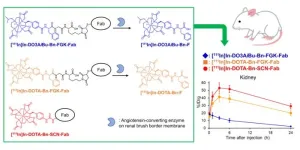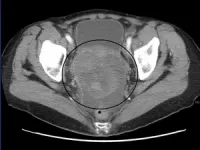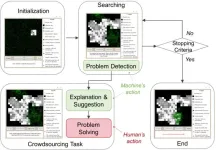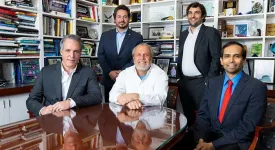(Press-News.org)
Radiotheranostics embodies the convergence of diagnostic and therapeutic radiopharmaceuticals into a unified platform. In cancer treatment, radiotheranostic procedures typically involve the use of antibodies that bind to proteins abundantly found on the surface of cancerous cells. The antibodies are labeled with a suitable radioisotope, which facilitates imaging procedures used to diagnose cancer and can be used to target cancerous cells and bombard them with deadly radiation as a form of treatment.
Although radiolabeled antibodies show promise as a treatment for cancer, several hurdles impede their clinical translation. The most notable impediment is slow blood clearance, which causes bone marrow toxicities. Meanwhile, radiolabeled antibody fragments show rapid blood clearance, but cause accumulation and slow clearance of the radiolabeled particles (or radiometabolites) from the kidneys, also known as renal retention. The challenge of elevated radioactivity in the kidneys from the radiolabeled antibody fragments—detrimentally affecting both diagnosis precision and therapy outcomes—has hindered the progress of radiotheranostics applications for more than three decades.
Recently, medicinal chemistry researchers from Japan’s Chiba University developed new radiolabeled antibody fragments and tested them in a murine model. They found that the novel radioisotope-labeled antibody fragments facilitate the rapid elimination of the resulting radiometabolites from murine kidneys. More specifically, the team developed 1,4,7,10-tetraazacyclododecane-1,4,7,10-tetraacetic acid (DOTA)-based reagents for radiotheranostic applications. Their study was made available online on June 16, 2023, and published in Volume 66, Issue 13 of the journal Medicinal Chemistry on July 13, 2023.
When asked about their novel molecular design, Dr. Hiroyuki Suzuki, the lead author of the study from the Graduate School of Pharmaceutical Sciences, Chiba University, explains, “We have developed a radiolabeled antibody fragment that reduced renal radioactivity levels, where we used DOTA as the radiolabeling part. DOTA is a promising chelator, where a chelator is a molecule that forms a stable complex with a metal ion, such as a radiometal; this would find potential radiotheranostic applications.” The team also developed an additional DOTA derivative and tested its efficacy using a murine model.
Prior research published by the same group addressed the issue of renal retention by devising a “renal brush border” strategy. It involved the introduction of an enzyme-cleavable linkage—a chemical bond that can be broken only by certain enzymes—between the radiolabel and the conjugation moiety that links it to the antibody. The enzymes on the renal released brush border membrane recognize and cleave this linkage, thus allowing the rapid elimination of radiometabolites through urine.
Building upon the renal brush border strategy, Dr. Suzuki’s team developed new radioiodinated antibody fragments with enzyme-cleavable linkages. After injecting the newly developed DOTA-based reagents into tumor-bearing mice, the team performed physiological imaging using single-photon emission computed tomography, which detects the gamma radiation emitted by the injected radiopharmaceuticals.
Experiments conducted on laboratory mice showed rapid renal excretion of the generated radiometabolites. Quite notably, one of the radiolabeled antibody fragments ([111In]In-DO3AiBu-Bn-FGK-Fab) showed substantial accumulation in the murine tumors, which highlights their potential as an effective diagnostic tool, paving the way for future clinical evaluation. Although the study authors admit the requirement of additional efforts to confirm its applicability to therapy, their findings show promising clinical applications.
Therefore, this research could accelerate the progress of radiotheranostics, combining improved diagnostic precision and therapy while minimizing potential side effects. “This study will contribute to the development of radiopharmaceuticals that can provide radiotheranostics capable of more accurate diagnosis and therapy with reduced side effects. Radiotheranostics can contribute to personalized medical approaches with tremendous benefits to the treated patients,” concludes Dr. Hiroyuki Suzuki.
About Assistant Professor Hiroyuki Suzuki
Dr. Hiroyuki Suzuki is an Assistant Professor at the Graduate School of Pharmaceutical Sciences, Chiba University. Dr. Suzuki’s research interests include diverse aspects of radiochemistry, radiopharmaceutical synthesis, imaging techniques, and therapeutic applications, contributing to advancements in nuclear medicine and cancer therapy. He has authored around 27 scientific publications.
END
For the 314,000 people diagnosed with ovarian cancer each year, hope often comes in the form of platinum-based drugs such as cisplatin.
Cisplatin causes the death of quick-dividing tumour cells, so it is a potent first-line defence in the treatment of the often fatal disease.
However, over half of ovarian cancer patients develop recurrence and become resistant to cisplatin and other platinum-based chemotherapies, contributing to the five-year survival rate of 31%.
It is unclear why this resistance occurs, but a solution is urgently ...
When artificial intelligence robots that have been designed to use algorithms to complete source search tasks, such as search and rescue operations during a fire, encounter a disturbance, they are often unable to complete their task. Proposed solutions have ranged from trying to improve algorithms to introducing additional robots, but these AI-driven robots still encounter fatal problems.
Researchers have proposed a solution: a human-AI collaboration that takes advantages of the unique skills of the human brain to overcome challenges.
The paper was published in the Journal of Social ...
A new physician-training system in telehealth simulates key parts of traditional, in-person neurological exams that use little reflex hammers, pinpricks, and flashlights to test nerve function. The three-year program, which was designed by researchers at NYU Grossman School of Medicine, has trained at least 68 neurology residents since its rollout in 2020. Published online Aug. 3 in Neurology Education, a new analysis of the curriculum identifies challenges to translating in-person exam techniques ...
Researchers from Texas Christian University, University of South Carolina, and RealPage published a new Journal of Marketing article that examines the impact of online reviews on hotel booking performance with a specific focus on the competitive effects of reviews.
The study, forthcoming in the Journal of Marketing, is titled “The Competitive Effects of Online Reviews on Hotel Demand” and is authored by Sanghoon Cho, Pelin Pekgun, Ramkumar Janakiraman, and Jian Wang.
Recent reports indicate that a majority of consumers trust online reviews as much as personal recommendations when deciding to book a hotel. A 2019 study ...
As drinking water flows through pipes and into a glass, it runs against the rubber seals inside some plumbing devices. These parts contain additives that contribute to their flexibility and durability, but these potentially harmful compounds can leak into drinking water, according to a small-scale study in ACS’ Environmental Science & Technology Letters. The authors report that the released compounds, which are typically linked to tire pollution, also transformed into other unwanted byproducts.
To enhance rubber’s strength and durability, manufacturers typically mix in additives. Scientists have shown that tire dust ...
The Icahn School of Medicine at Mount Sinai announced today that it has signed a memorandum of understanding with the Brazilian Clinical Research Institute (BCRI) to focus on advancing cardiovascular disease research, innovation, and medical education.
"This partnership is part of a broader initiative to expand Mount Sinai Heart’s reach globally, and Latin America is an important part of that goal," said Deepak L. Bhatt, MD, MPH, Director of Mount Sinai Heart and Dr. Valentin Fuster Professor of Cardiovascular Medicine at Icahn Mount Sinai. "Our partnership ...
As summer draws to a close, the long vines and tendrils of most melons and gourds in the Cucurbitaceae family snake their way along the ground. And they’re dotted with fruits, such as cucumbers or pumpkins. Below are some recent papers published in ACS journals that report insights into melons’ potential health impacts, pathogens and contaminants. Reporters can request free access to these papers by emailing newsroom@acs.org.
“Nanoparticles Loaded with a Carotenoid-Rich Extract from Cantaloupe Melon Improved Hepatic Retinol Levels in a Diet-Induced Obesity Preclinical Model”
ACS ...
Cambridge, MA (September 6, 2023) — The Broad Institute of MIT and Harvard today announced a new research alliance with Novo Nordisk aimed at addressing critical unmet clinical needs in diabetes and cardiometabolic diseases. The collaboration will focus on advancing three programs over the next three years. Two programs aim to identify drug targets for clinically important subtypes of type 2 diabetes, which affects more than 37 million people in the United States alone, and one program aims to unravel the genetic roots of cardiac fibrosis, or scarring of the heart, which occurs in many cardiovascular diseases that can lead to ...
HOUSTON and SAN MATEO, Calif. ― The University of Texas MD Anderson Cancer Center and Panacea Venture today announced the launch of Manaolana Oncology Inc., a new company created to develop and advance antibody-based therapies against novel cancer antigens.
Manaolana Oncology seeks to build upon the innovative antibody production capabilities and intellectual property of MD Anderson to research and develop novel monoclonal antibodies (mAbs) and other antibody-based therapies for a variety of cancer types, with the goal of advancing promising therapies into ...
Research Highlights:
Obesity-related cardiovascular disease deaths tripled between 1999 and 2020 in the U.S.
Such deaths were higher among Black individuals (highest among Black women) compared with any other racial group, followed by American Indian/Alaska Native people.
Black adults who lived in urban communities experienced more obesity-related cardiovascular disease deaths than those living in rural areas, whereas the reverse was true for all other racial groups.
This news release has been updated to include ...




